The ultimate guide to board meeting agendas
- Chapter 1: Setting your board agenda
- Chapter 2: The chair owns the Agenda
- Chapter 3: The top 13 agenda building tips
- Chapter 4: Why agenda's deliver more productive board meetings
- Chapter 5: Building your board agenda
- Chapter 6 Recorded webinar - Setting the board agenda
- Chapter 7 The importance of embracing a strategic board agenda
Setting your board agenda
The way a board meeting agenda is structured will dynamically affect the quality of the board's focus and its ability to handle the big decisions that are required to create the future. This is further supported by the quality of board reports that provide succinct, focused information that facilitates the board to understand the choices they have. The board agenda and the board reports need to work in concert with each other. If the board agenda is focused on receiving reports on activity, and the board reports only provide updates on activity, then the board is not fulfilling its purpose.
It is imperative that the board and the members of the executive team collaborate in a close and productive partnership. Both groups must ensure that the board maintains an appropriate focus on the board-approved strategic priorities. Academic research shows that there are three main reasons why a board will move from strategic matters and descend into operational matters:
Other interesting articles
The chair owns the agenda
Who prepares the first draft? Usually the company secretary, the CEO or the board secretary. This then needs to be approved or amended by the chair. The agenda and the board papers need to be sent to all directors at least 5 days plus a weekend, prior to the board meeting.

Two days before the board meeting, set a time for directors to seek clarification or request to add items worthy of board discussion. It's the chair's decision for what is on the agenda and what is not. If the chair is not managing this well, assist them or replace them (circumstances depend on how the chair was appointed by the board or by members/shareholders).
The top 13 agenda building tips
1. Place your vision at the top of the agenda
This can remind all present 'why' your organisation exists and why you are there; it is not just for the sake of holding meetings. It can also be used by the chair to draw people to consider where the conversation should go. It can also be used to guide behaviour of recalcitrant board directors.
2. Create a colourful cover sheet or include a service user story
Plan International uses a cover sheet for every board agenda pack. They include a photograph of their important work or key projects plus a short description. This can help to remind board directors of the reasons why the organisation exists. Alternatively, spend ten minutes exploring a service user story or a mission moment.
3. Place strategic matters ahead of operational matters
This helps to overcome the problem we see too often where a meeting delves into operational matters for extended discussions and then finds there is not enough time left to deal with the strategically important stuff. Prioritise the first part of the meeting for strategic matters. Rather than a CEO Report, create a CEO and executive team report on strategic priorities and align it to the strategic plan structure and deliverables. A key section of this report should be 'What keeps the CEO awake at night'.
4. Use a consent (or block) agenda
The Consent Agenda technique is a powerful tool that reduces the amount of time spent on reports that are ‘For Noting’ only. This is sometimes called a block agenda (i.e. where a group of items are placed together and approved by the board as a ’block’).
These items for Noting Only will be voted to be accepted as group (or as a block item). Up to 48 hours before the meeting, board directors may request that the chair take an item off the consent agenda item so that it can be discussed by the full board. It is at the Chair's discretion whether to allow the item to be moved onto the agenda for discussion (or not). This technique separates out matters that the chair and CEO believe are not worthy of any discussion, usually only reports on progress or information with no action required. If the chair is not convinced by this director, then the chair can still recommend that all ‘consent agenda items’ are accepted as they appear in the agenda. As well as separating out Items for Noting, you should also have Items for Discussion and Items for Decision by the Board. Please note that any Items for Information should be sent out separate to the agenda, or stored in a resource library or board management software or board portal.
5. Colour code or name your agenda actions required
On the agenda, you can colour code the item, depending on the action required from the board. If you are using a board management software such as BoardPro, add your notations into the 'purpose' field as a guide.
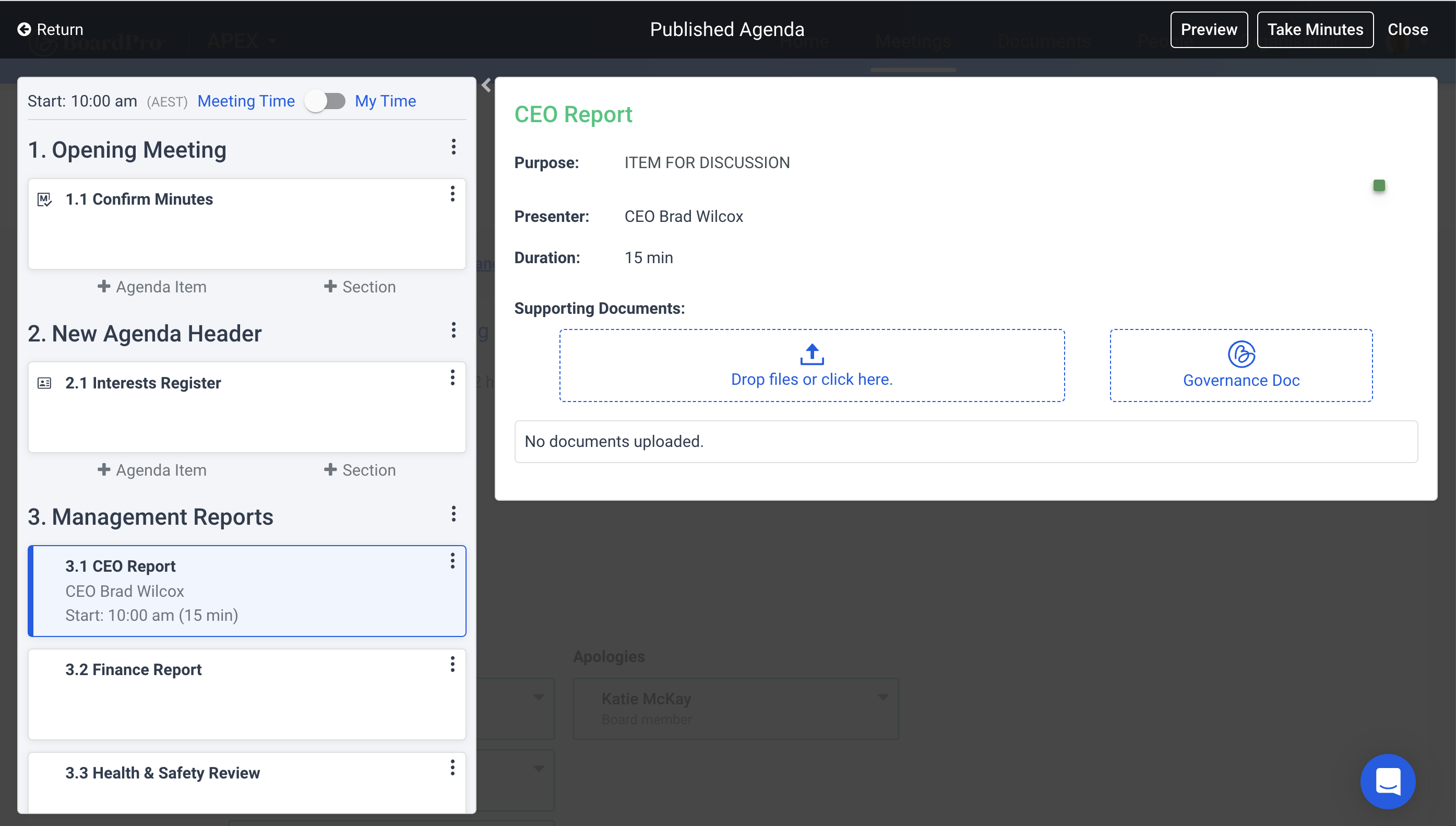
6. Create a standard heading on all reports
This heading should read 'Strategic Implications for Board Discussion' (or similar). Some of the time, there may be a single word 'Nil' under this heading. Other times, staff or board committee will appropriately articulate the issues of strategic importance that the board needs to consider. Even if the word 'Nil' appears, the mere presence of this heading may prompt a director to raise a strategic issue or question related to the topic.
7. Careful use of ratios
When determined in advanced, some selected, key ratios can help the board to focus on the strategic issues behind the finance and other numbers. If you use ratios, create a legend to explain what they mean. This can be helpful to directors who are not familiar with the use of these ratios. It can also introduce clarity as there are some ratios that are defined or used differently in different sectors. Define the trigger points for action should the ratios fall outside the acceptable and agreed levels.
8. Manage ‘board owned risks’ and seize opportunities
By creating a separate classification for board-owned risks, the staff team can more easily summarise the risks that require attention and oversight by the whole board. Naturally, the board committee overseeing risk should see greater detail and monitor the treatment of major operational level risks. The CEO and staff must maintain even stronger vigilance over all risks.
Remember: Any risk identified can present potential business opportunities, especially if you can manage them much better than your competitors. Help the board focus on the opportunities associated with risks by considering the opportunities and the potential increase in business available.
9. Use dashboard reports
These summary-style reports can graphically represent and summarise key data. Make sure that the dashboard reports measure the items that represent the real health / real impact of the organisation. While it should cover operational and financial matters, don’t forget to include key people measures like culture, satisfaction, staff and safety matters. Trend information, and succinct commentary from management can also be integrated into dashboard reports to make them more useful for directors.
10. Use leading indicators not lagging indicators
Like most financial reports to boards, many operational reports also look backwards at what the organisation has done. Though sometimes challenging to define, leading indicators can become a useful proxy measure for future success of the enterprise, rather than what is already behind the organisation.
11. Measure the right things
Often board reports are full of data that are unhelpful as information for directors (or even management). Client numbers and targets often figure prominently in many board reports. One client might generate $10k per year in services with the organisation; another one may generate $800k. Some clients cost you money to service; others yield a surplus to support the whole business.
While many organisations measure new clients signed up, they often fail to disclose how many clients were lost, and what the full year impact of those losses are worth to the organisation. Finally consider benchmarks and targets. Are you measuring the real outcomes of your work, or just activity or outputs?
12. Include a CEO and CFO declaration
Every financial report provides useful information for directors about financial performance. At the end of the financial report/s, the CFO should include a declaration to the board that they believe the organisation is solvent. Also include details of currency of key payments to external parties relating to Superannuation Guarantee, other super funds, and the ATO for PAYG and GST. Include date paid up until, and the date next payment is due. CEO should countersign this declaration and key information.
13. What should be on your agenda in the new year?
After several recent Royal Commissions in Australia, it is certainly clear to Conscious Governance and BoardPro that organisational culture must become a stronger point of focus for all boards. As a start, you should ask each director and the full board “Is the culture of our organisation where the board requires it to be?.
Why agendas deliver more productive board meetings
Over the years we’ve had many ongoing conversations with people about board governance. What we have learnt is that effective board meetings are those that are ‘front loaded’ i.e are directly proportional to the front work in the agenda and the preparation of supporting documents. The success of board meetings are also much more likely with strong support processes. That said, they are still dependent on strong executive-director/board relationships, good attitudes and conduct during the meeting.
There are four key areas to manage; 1) meeting preparation, 2) day of the meeting, 3) post meeting and 4) meeting resources.
How effective is your board of directors, and what can you do to improve your governance? Learn the best practices for conducting a productive board meeting.
Building your board agenda - a quick tour
Looking for a refreshingly simple way to create agendas for your board meetings?
Watch this short overview to see how BoardPro's smart agendas can save you hours of time, and ensure that your entire board is on the same page.
Setting your strategic board agenda - a webinar
Learn how to develop and structure a strategic board agenda that keeps the board focused on the important matters during the meeting. Click here to watch the recording of the webinar.
Focus only on those strategic items that matter
Do your meetings tend to get unfocussed or off-track, or are they a sound use of time, focusing on strategic items that move your organisation forward? Provide your directors with clarity on what they should do with each paper, and reduce the amount of time wasted on ineffectual discussions.
Key Learnings
There are only 11 (or so) opportunities for your board members to come together for their cyclical board meeting in a year. This webinar will help you;
- To see how a strategic agenda can be constructed with ease
- Learn how to keep your board focused
- Minimise the amount of unnecessary information going to your board
In this video, you will learn how to create a concise and coherent strategic board meeting agenda.
Embracing a strategic board agenda
Creating a strategic board agenda is no trivial task and it goes beyond structure. However, when a strategic board agenda is effectively achieved, the organisation will enjoy tremendous growth prospects. Continue reading to understand the core issues surrounding the process of adopting strategic board agendas.
1. How aware is the board of its duty and the worth it must provide to the organisation?
Strategic board governance has been described by many different writers in a ton of documents and articles and it refers to the actions the board must take to drive growth in the organisation so important goals can be reached.
A few approaches are adopted to achieve this, such as governance manuals, board charters, and detailed descriptions of board duties to distinguish them from the duties of management. Because detailed documents like these are provided, the board understands that it must work on the business, not in it. In other words, they are in charge of keeping their eye on the big picture.
The documentation of board duties doesn’t only lead to efficiency and improved strategic performance; it also helps the induction of new board members. When someone new is about to join the board, they need to be provided with a clear definition of their role and responsibilities.
It is also essential that the board’s standards and duties are constantly evolving, otherwise, innovation and the improvement of organisational governance patterns will be impossible to maintain.
2. Is the board guided by a work plan?
Having a detailed work plan is essential for the board to create original and effective strategies. Highly effective boards are guided by work plans that help them direct their discussions to identify relevant matters over a specific period.
A work plan must detail the exercises the board must do, such as annual general meetings, as well as the contractual exercises, such as wage reviews. It must also identify the matters surrounding the development of policy and strategy.
Typically, effective work plans will provide a structural organisation of the issues that are most important to the core functions of the board, it schedules and prioritises these issues for consideration. As such, the annual board agenda is divided into manageable chunks that determine the content of every board meeting throughout the year.
A work plan provides the board with a compass that guides its activities and helps them maintain the focus on the most important duties of the organisation. Without it, the board can easily stray from important issues, particularly as it relates to long-term matters that require the board’s deliberation.
This is not at all related to management or what they present to the board on monthly basis, but it is related to what the board wants to do and what it needs from management to get it done.
3. Does the board leverage inverted meeting agendas?
It’s not uncommon for boards to start their board meetings discussing the reports and Minutes of the previous meeting, proposals made by management and committee, and arising matters. In other words, boards spend a lot of time dwelling on the past while leaving talks about the future and important board agenda matters to the end of the meeting.
Eventually, boards will reach a point where they have many important matters to discuss and not enough time to do so. As a result, they will start to rush through key agenda items, which require a lot more attention than that. Hopefully, they’ll have an opportunity to revisit unresolved matters in the next meeting.
This is a common issue, but there’s a simple solution that’s rarely acknowledged and it involves turning the agenda on its head. That means boards should start their meetings by discussing the most mentally demanding and important matters.
Once those items are thoroughly discussed, the last minutes of the meeting can be dedicated to the discussion of reports from the previous meeting. This way, if the board runs out of time, members won’t have to rush through important matters, and they can afford to act as if the reports have been read. They can even postpone the meeting to discuss reports and other issues.
By leveraging an inverted agenda, the board will become more efficient and board meetings will be a lot more coordinated, to the point that there will be little time to dedicate to irrelevant issues. Interestingly, there are two ideas at work, 'the parking lot' and the 'consent agenda'.
The former idea is focused on the board recognising an issue or set of issues as relevant and fit for future discussion, which means they can be parked away for the time being. The latter idea is all about bundling and rubber-stamping the inconsequential decisions the board must take for legal reasons so they can be taken care of in one fell swoop.
4. Does the board understand the purpose of the agenda's design?
The board must understand why the agenda was designed in such or such way because they need to connect with it. If they don’t feel a sense of ownership or purpose, their deliberations would make little to no impact. Additionally, if this is done correctly, irrelevant items will be removed, saving the board some time.
If this is supported with an added policy reference to each board paper, it will have an even greater impact. After all, the board needs to connect the report to their policy and strategic agenda. That’s the entire essence of it. This approach circles us back to the questions of the board’s duties, how it helps the business grow, and whether or not the discussions relate to the strategic results intended for the organisation.
5. How well do the board chair and chief executive understand the board's duties?
Board meetings don’t occur daily, which means the board doesn’t spend too much time deliberating about the future of the organisation. Therefore, it’s essential to spend this valuable time discussing important matters relating to strategy and the effective elevation of the business.
When the chief executive and board members don’t understand the duties of the board, it will become easy to wander around discussions that are not in the scope of board meetings.
6. Are board papers sent to directors for their thoughts before board meetings?
The idea of sending board papers to directors before board meetings to get their thoughts is to help them understand the essence of the report so they can prepare. The unpreparedness of board members is something that commonly affects boards, and it results in the quick merging of financial and operational reports that are only relevant for management.
Most of the time, directors skim through these flaws when they don’t receive board papers before the meeting. On the other hand, if a board paper is perfectly crafted and prepared, it will expose unprepared board members. Effective boards will engage in helpful discourse, which requires board papers to be distributed timely for prior reflection and thought.
7. How much potential do board members have for strategic operations?
It’s usually a challenge for many organisations when board members are more interested in operational activities than they are in top-level strategic duties. However, this strategic governance is not a responsibility suited for everyone. That means that many of the boards out there are changing the process by which they choose their board members.
The main objective here is to make sure board members can contribute sound intellectual dexterity and leadership to elevate the entire operation of the organisation. After all, this is the main goal of the board and it’s why it was set up in the first place.
8. Do the board and its members have a Performance Feedback Mechanism to determine the quality of their performance?
Tools to monitor and score the performance and contributions of board members to the board and the organisation are essential for all boards. Often, this is achieved by setting up a yearly performance review scheme for the board and its director. This is the most common approach, so much so that organisations don’t have any excuses for failing to adopt it.
Recently, stakeholders have a lot higher expectations for the board, no matter if the organisation is not-for-profit or for-profit. The status quo is for the board to leverage performance reviews to improve the way it serves the organisation and everyone on it.
Embracing a strategic board agenda will allow the organisation to grow tremendously, so it’s not something that should be taken lightly. It’s a task that requires attention to detail because the success of its achievement is what will allow the business to thrive.
The questions explored today address the most common concerns about the adoption of a strategic board agenda and the answers we’ve provided will give you the insight you need to craft this effective tool that will make such a big difference.
Interested in exploring paperless portal options for your company?
Schedule a demo with our team today and begin to experience a whole new way of meeting.
Governance made easy
Imagine board meetings with everything in one place and everyone of the same page.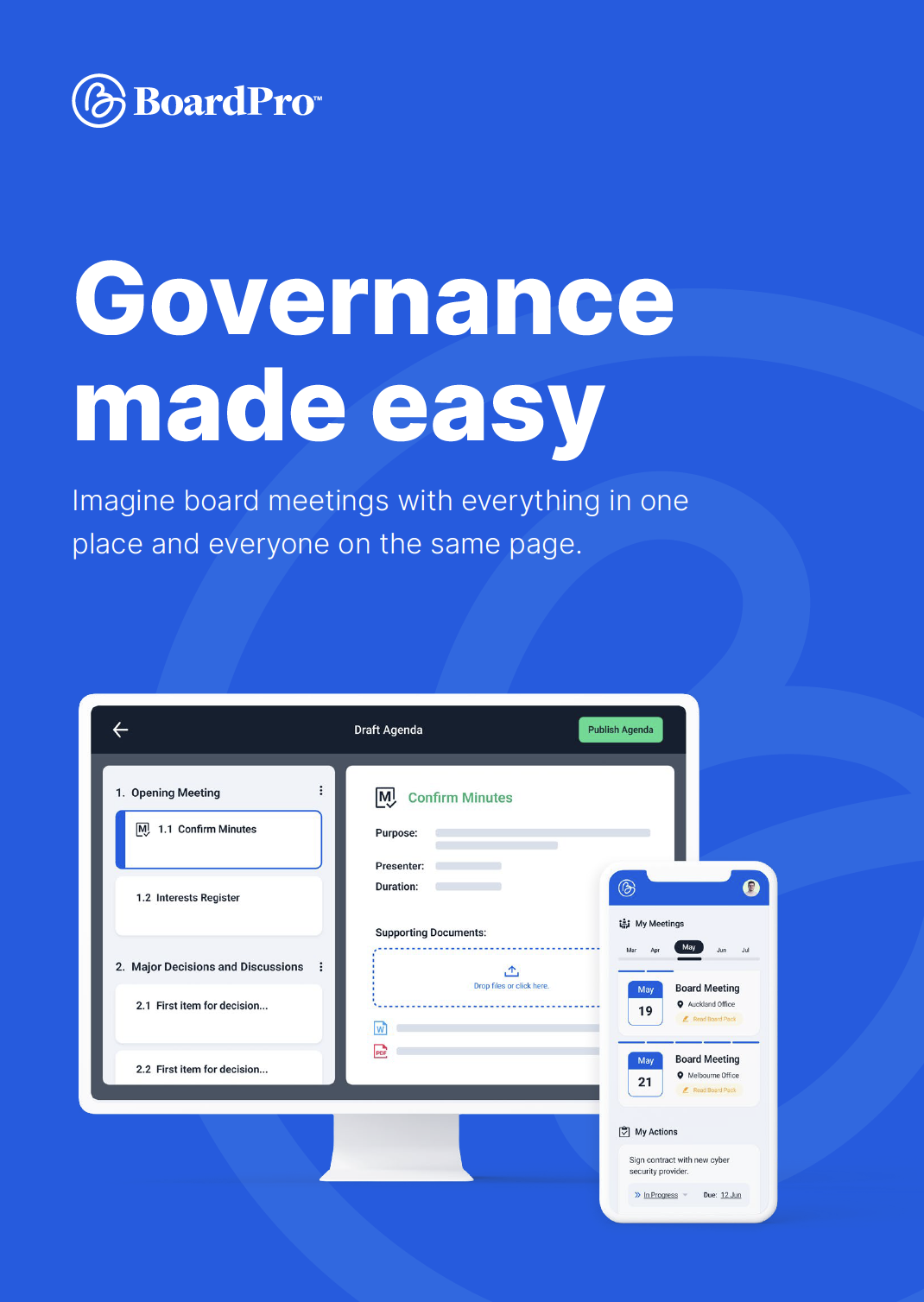
From Our Blog
Stay up to date with what is new in our industry, learn more about the upcoming products and events.
.png)
The Institute of Community Directors Australia and BoardPro partnership
.png)
How to write a board code of conduct
%20(1).png)
Partner profile: Sarah Taylor of Meetings Into Minutes
Thousands of boards around the world trust BoardPro
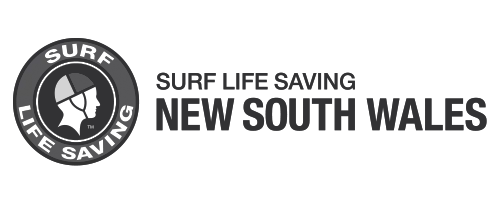



.png?width=100&height=100&name=master-builders%20(2).png)

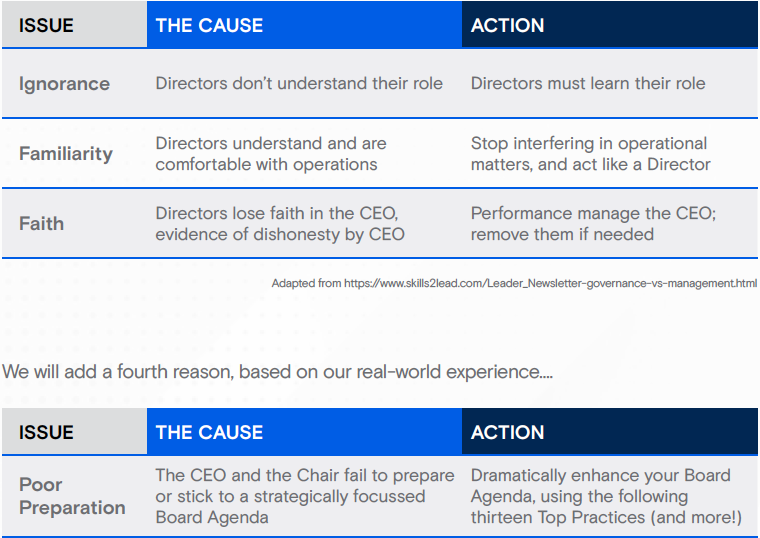
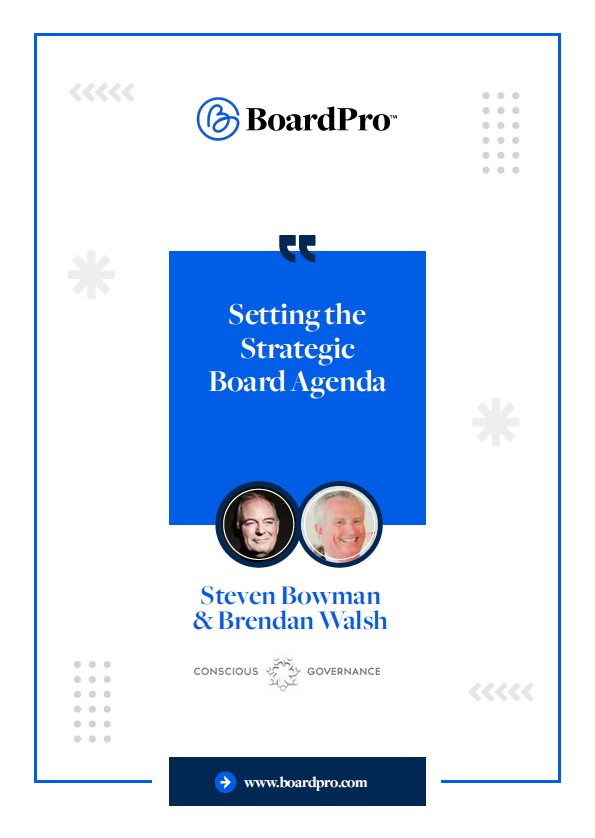
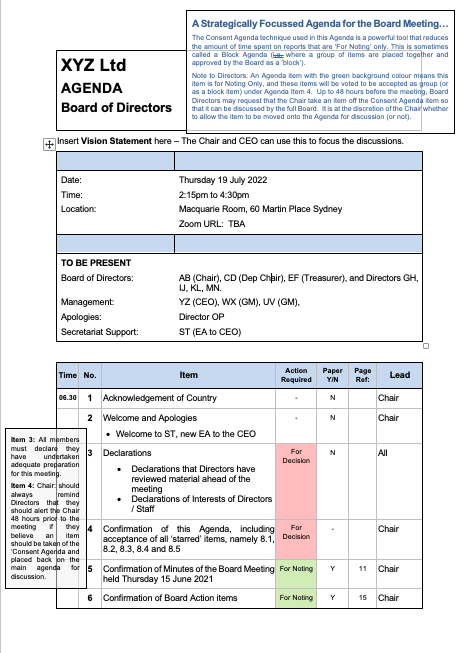
.png?width=1920&height=1280&name=mockup-of-a-magazine-in-the-hands-of-a-man-with-a-blue-shirt-3384-el1%20(23).png)

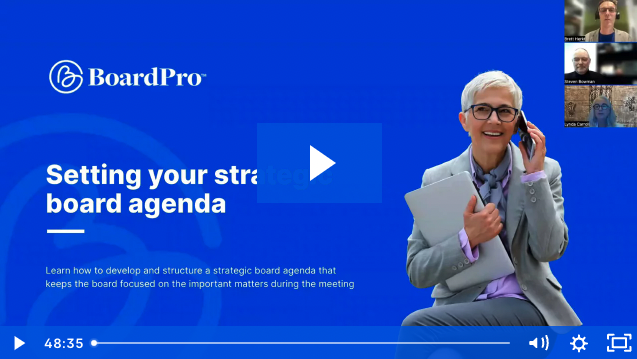

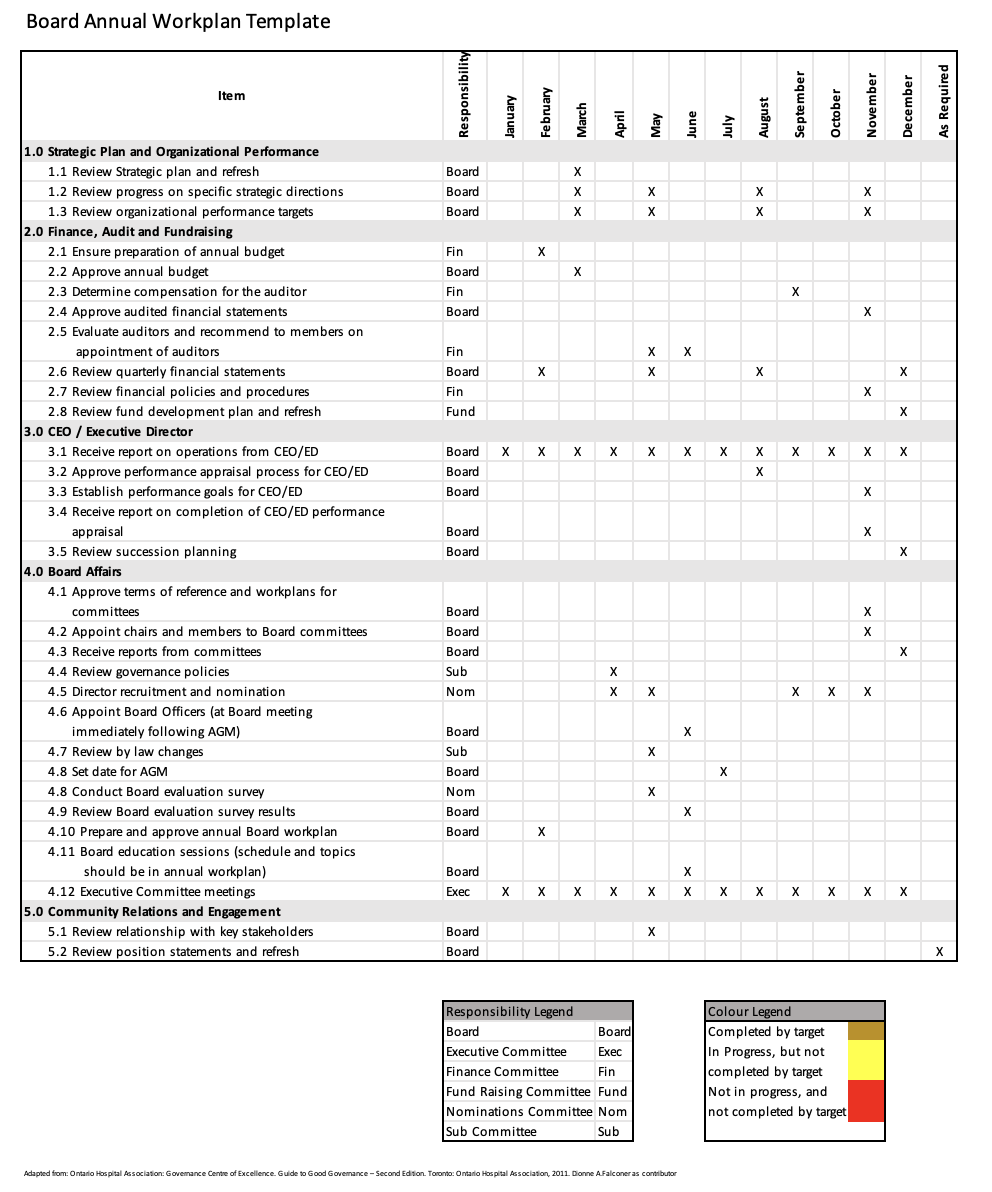



.png?width=760&height=760&name=Patrick%20(1).png)
